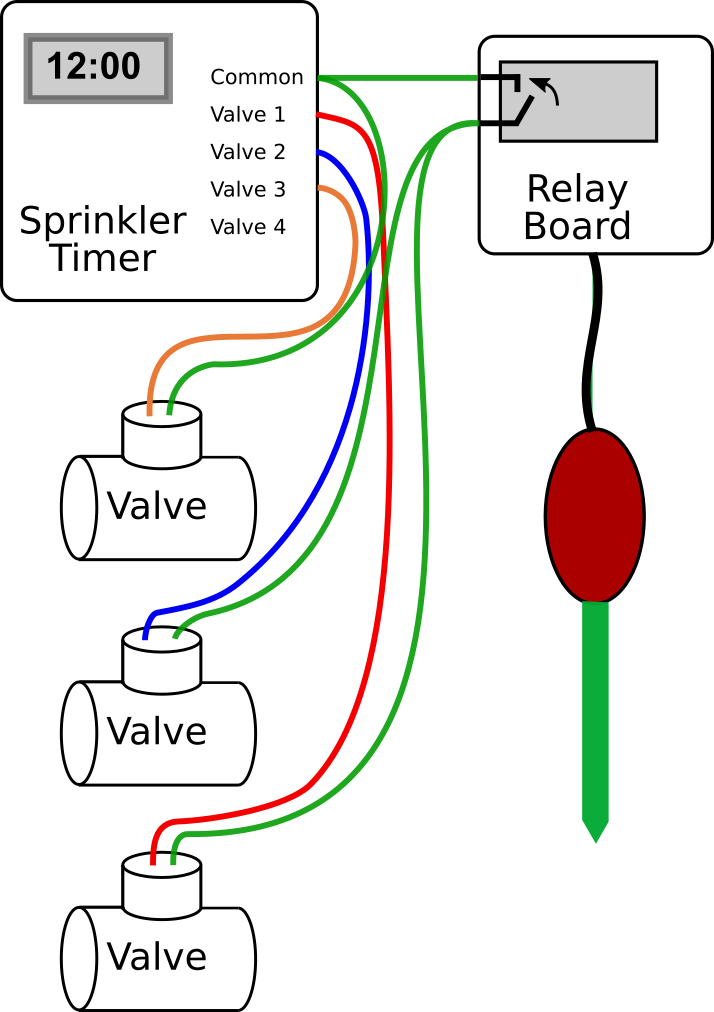How to Control Multiple Sprinklers with a Single Moisture Sensor
This article will explain how you can control multiple sprinkler valves with a single Vegetronix moisture sensor, a relay board, and a generic sprinkler timer.
We often get the question of how many moisture sensors are needed in an irrigation system. The number depends upon upon how many watering zones you have, and the granularity of control that you want. The systems that save the most water use a moisture sensor for each watering zone. While using a single sensor across multiple valves is not optimal for water savings and control, you can still get significant water savings using this method.
Using a single sensor across multiple valves is similar to the way an irrigation clock with a rain sensor input works. When it rains, the sensor detects that their is sufficient moisture and blocks the sprinkler timer from running across all of the zones.
Using a moisture sensor for multiple zones has an added complication in that if the sensor is placed in the first watering zone, it will run the sprinkler valve until the ground is saturated, and subsequent zones will be disabled and never get watered. There are two approaches to placing the sensor for multiple zones, each with different tradeoffs.
The first approach is to place the sensor outside all of the zones, and use it as a rain sensor. In this case, if the sensor detects that the soil is wet, it will turn off all zones for the cycle, and if it's dry it will run the full cycle for all of the zones even if the soil becomes saturated.
The second and better approach is to place the moisture sensor in the last zone which is watered. In this case, if at the start of the watering cycle the last zone is wet, all of the zones will be blocked for the entire cycle. If the zone is dry at the start of the cycle, the zones that are watered before the final zone will be completely watered for the entire watering cycle, even if they become saturated with two much water. Only the final zone with the sensor will be turned off before the end of the cycle, and watered perfectly.
Moisture sensors can not control anything by themselves, because they are just sensors. To control valves you need a control board which reads the sensor, and then flips a mechanical relay or electronic switch. Vegetronix carries 4 different types of control boards.
They all have the same principle of operation, in that they read the moisture sensor, and then block the signal from the irrigation clock to the valve, if the soil's moisture is sufficient. If the soil is dry, they pass the signal, and the valve turns on.
The following table shows the use case for each of these controllers. They all work with Vegetronix soil moisture sensor.
| Control Board | Use Case |
|---|---|
| VG-RELAY-AC | Use this controller when you want to control each zone individually, and your valves are 24VAC solenoids valves and you are using an irrigation timer. These can not control more than a single valve, and can not control pumps or high power devices. |
| VG-RELAY-LATCH | Use this controller when you want to control multiple valves from an irrigation timer, or control high power devices such as pumps. This board can be battery powered. |
| VG-RELAY-DC | Use this controller when you want to control multiple valves from an irrigation timer, or control high power devices such as pumps. This board requires wall power, and can not be powered from a battery. |
| VG-HUB-RELAY | The relay hubs are more sophisticated because they are wifi enabled, and do not require an irrigation timer. These allow you to view your sensor data on the Internet, from any web browser. |
The following diagram shows you how to hook up one of our VG-RELAY-LATCH or VG-RELAY-DC controller boards to a sprinkler timer, and to multiple zones.
Valve 1 is not connected to the relay board, and so the cycle of zone 1 will not be controlled by the moisture sensor. Valve 2 and 3 have their common wire connected through the relay board, and so when the sensor detects too much moisture, the relay will open and block the signal to the valve, shortening the watering cycle, and saving water. When the Vegetronix soil moisture sensor detects that the soil is dry, the relay closes, and the signal from the irrigation clock passes to each of the valves.
The valve watering order is important when you are using a single sensor. If the soil moisture sensor is placed in the first zone, then the other zones will never get watered, because the first zone will get watered, and then block the signal to the other valves. Always put the sensor, in the last zone to be watered, or reorder the wires on your irrigation clock such that the zone with the sensor is last to be watered.
